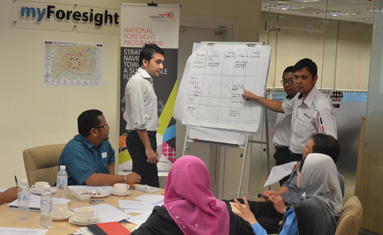by | Major (R) Zailani Safari, Vice President, Offset Management & Consultancy
It is a vision of the Malaysian leadership to create a high income society by the year 2020. In order to achive this vision Malaysia, a successful commodity and manufacturing nation, needs to develop its technology capability and capacity to become a knowledge-based economy.
Malaysia targets six percent (6%) annual economic growth. To achieve this, Malaysia needs to improve its capacity and capability in high technology and a combination of factories that make high technology products and a vibrant services industry. It must be able to produce a diversity of high-tech products and services with better prospect for exports.
To create a high income society and to achieve a high income economy, Malaysia has to have a focused economy, an economy that focus on a few sectors of high value based on innovation with concrete potential. In order to have a stable economy, Malaysia needs to move into sectors that are not prone to bubble economy.
Offset programs could be used as platform to support the Government aspiration to develop competitive nation and high-income society. In general, offset arrangements are parts of the contract agreements that are designed to help purchasers obtain the desired transfer of technology and provide local employment. Offsets programs can also be viewed as contracts that require the seller to transfer extra economic benefits to the buyer as a condition for the sale of goods and services.
a) Definition and Policy
Malaysia refers to its policy generically as ‘offset management policy‘, usually requiring contractors to discharge obligations with offsets and counter trade in two forms (as shown in Figure 1):
The direct offsets are defined as anything related to main procurement contract comprise of activities and packages agreed by the seller and the procuring Government such as:
Capability Development
Local work packages
Transfer of Technology and Competency Development
Indirect offsets are programs that are not directly linked to the base product procured, which can be any activities agreed by the Government:
Transfer of Technology (ToT) and know-how
Research,Development andCommercialization (R&D&C)
Local Content
Access to Global Market
Foreign Direct Investment (FDI)
At present, the national offset policy was published by the Ministry of Finance in early 2011 and in overall command of the policy. The Malaysian Industry Government Group for High Technology (MIGHT) has assumed a high profile role in addressing the technological development needs for the country. Under the policy, all ministries work closely with MIGHT, which acts as a Technology Depository Agency (TDA) and provides offset management services which include the identification technologies required by the nation.
b) The Approach
The main objectives of the offset programs are to diversify the economy in-line with the aspiration of developing knowledge-based economy and innovation-led society. To achieve the objectives, the Malaysian National Offset Policy was developed with the following guiding principles:
Foster strategic international partnership that can contribute to economic and industrial enhancement;
Maximize the usage of local contents and reduce the outflow of currency;
Establish a sustainable Malaysian industrial and economic basis, with strategic capabilities and industrial participation in the global supply chain;
Promote Transfer of Technology (ToT) and know-how;
Collaborate in strategic Research ,Development and Commercialization (R&D&C) projects; and
Facilitate investments and collaborate in strategic Human Resource Development (HRD).
Offset arrangements are parts of the contract agreements that are designed to help purchasers obtain the desired transfer of technology and provide local employment.

Malaysian Offset Program Management Framework
The Malaysian Offset Management Framework was developed and published in the policy as a guideline for the offset program development and implementation. The elements in the framework as shown in Figure 2 are as follows:
- Establishment of Offset Management Committee-established to supervise the Offset Management Framework activities:
- Offset Requirement Document (ORD) development – An ORD will be prepared by the secretariat with the approval from the OMC to be used to assist the Government in selecting the best Bidders.
- Bidders Offset Proposal Submission – ORD will be distributed to the bidders for their reference by the Offset Management Committee secretariat.
- Audit of Technology Recipient – TDA will carry out activities to audit the technology recipients. It is an organizational audits conducted on potential beneficiaries to ensure the offsets offered can be realized by the beneficiaries.
- Offset Proposal Evaluation – Discussion and negotiation based on the submission received after the response closing date will carried out with emphasis on the current requirement and solution of the country from the perspective of socio-economic benefits and returns, solution on important and nation-wide issues, etc.
- Offset Agreement – Once the winning Bidder has been selected, an Offset Agreement is to be signed by the Government of Malaysia and the winning Bidder.
- Offset Program Implementation Monitoring– The implementation of the agreed projects in the Offset Agreement will be monitored by a monitoring body chaired by the implementing agency.
- Audit of Technology Transfer – Audit of technology transfer is an assessment of the technology recipient performance at the end of the technology acquisition period.
- Relief of Obligation – Upon the success of the offset activities and Post Implementation Audit, the Offset Obligor will be relieved from the obligation with approval from OMC.
OFFSET AS AN ECONOMIC DEVELOPMENT TOOL
The offset programs can be realised in some form of economic activity beyond the Base Exchange that governments require or encourage when accepting bids for procurement orders. Therefore, offset programs output in forms of contribution to national Gross Domestic Products (GDP) development or Gross National Income (GNI) and absorption capability by beneficiaries is key element for offset to work. Using the concept of “Triple-Helix” (Government-Industry-Academia collaboration), beneficiaries from the industry must work together with the universities, research institutions and Research and Development units of the technology supplier organisation in industry/market-led collaborative projects to position their products in the market for end-users applications. A network of key stakeholders, including foreign technology suppliers, anchor recipient companies, anchor R&D companies and the various domestic R&D institutions, will become supporting elements for this development to materialise.

Developing countries like Malaysia need to leverage on different tools to maximize economic returns to the country. Offset programs can be used as one of the tools and the following factors shall be considered in an offset program to make it as an effective economic development tool:
Technology needs in key sectors related to the procurement;
Market landscape, demand and size on the technology identified;
Close collaboration between the policy makers,the administrating agencies and the implementers in implementing the technology acquisition processes; and
Identification of the ‘right’ beneficiaries to implement technology acquisition effectively.
b) Long Term Strategic Goal
The framework developed for technology acquisition in Government procurement, will make possible the “matching-up” of offset with the country’s technological needs and market demand. Therefore, national procurement can be better positioned to serve as a crucial entry-point for new technologies into Malaysia as well as positioning of local technology in the global supply chain. As such, dynamic offset program plans are needed to address current national technology development needs, guided by relevant national economic development plans and strategies including the 5-year and 10-year Malaysia Plans, Industrial Master Plans, Science and Technology Policy, and other documents endorsed by the Government. Inputs from the industry players will be gathered, rationalised and the current needs of the country must be identified to ensure the strategic goals are valid and doable. The Malaysian Offset Executive Committee (MOEC) chaired by the Ministry of Finance is to ensure that activities identified in the Offset Program are in line with the national strategies and will give maximum benefits to the national technology development.c) ORD Development
Offset Requirement Document (ORDs) are documents developed by TDA as guideline to the suppliers to propose offset programs as requested by the country. The ORDs provide a wish list so that the offset program will be developed based on requirements by Malaysia rather than being dictated by the suppliers. Evaluations on the proposed programs are carried out using the ‘weightage’ approach on the bidders’ compliances to the requirements specified in the ORD. The evaluation parameters are based on:Compliance–itis a resolution on howthe biddercomplies to the ORD
Alternatives – it is a resolution on the options offered by the bidders in case they cannot fully comply with the ORD
Risks – it is an identification of risks associated with programs from the technology provider and recipient perspectives.
d) Offset management experience
Offset programs interface with multinational industry players and high-valued industries. Therefore, the resources involved in the offset program management shall have adequate experience and knowledge to handle international negotiations and dealings. The offsets do not come in free as such, that the offset obligors will find means and ways to ensure that the offset program cost is minimized and the outcomes are always in favour of them. Therefore, the corporate knowledge management approach to institutionalize the handling of the offset management is crucial to ensure that the long term capability development strategy through offset is achieved.
The overall offset management shall provide provisions for changes due to unforeseen circumstances. Offset management is a long term business management; as such it needs provision for changes and shall be dynamic to cater local and international business landscape change.
Offset program was implemented to drive economies. Countries such as Japan, South Korea, United States and Taiwan have used offset program as catalyst for their economic development. Effective management and execution of the programs by dedicated organizations enable those countries to reap maximum benefits leveraging on strategies outlined by the government.
A good offset policy is one that gives attention to the economic situations of both purchasing country as well of the country wishing to make the sale. The difficult task in managing an offset policy is to reach an unbiased balance between the obligations to be imposed, and the cooperation it seeks to establish. In the event of successful balancing act, offsets can be used as a tool of development and positive commercial cooperation. Five important factors for the success of an offset program are realism, anticipation, dialogue, moderation, and imagination. In ensuring that offset programs satisfies the national needs that contribute to the economic growth, the main procurement evaluation shall acknowledge that offset programs shall contribute significantly to the decision making based on the main contract. In doing so, the offset programs are to be structured that they contain elements of economic growth contributions such as job creations by encouraging the development of local industries and maximise the utilisation of local resources; development of local economic engines capability and capacity; market openings for local products; and technology development through knowledge generations and knowledge transfer.
The offset programs shall be designed to support the economic transformation from manufacturing economy to innovation economy aspired by the government. Therefore, the implementation of the Offset Program Management framework shall be dynamic and has provision for rooms to incorporate elements of innovativeness to allow changes required in supporting vibrant and innovative economic growth. It shall also give emphasis on the importance of technology identification to ensure offset meets the national objectives; ensure commitment of the beneficiaries to absorb technology; establish continuous industrial/academic links; evaluate economic feasibility of the technology and thus ensuring long-term sustainability; and improve the management of technology acquired.
The strategies shall consider the long term impact that lead to the commercialization aspect by establishing of market share for Malaysian good; increase of market share by opening up new markets; product positioning in the market; and attract foreign investment. In conclusion, offset programs as a platform of technology transfer is feasible provided it is managed properly by capable and competent organization.









